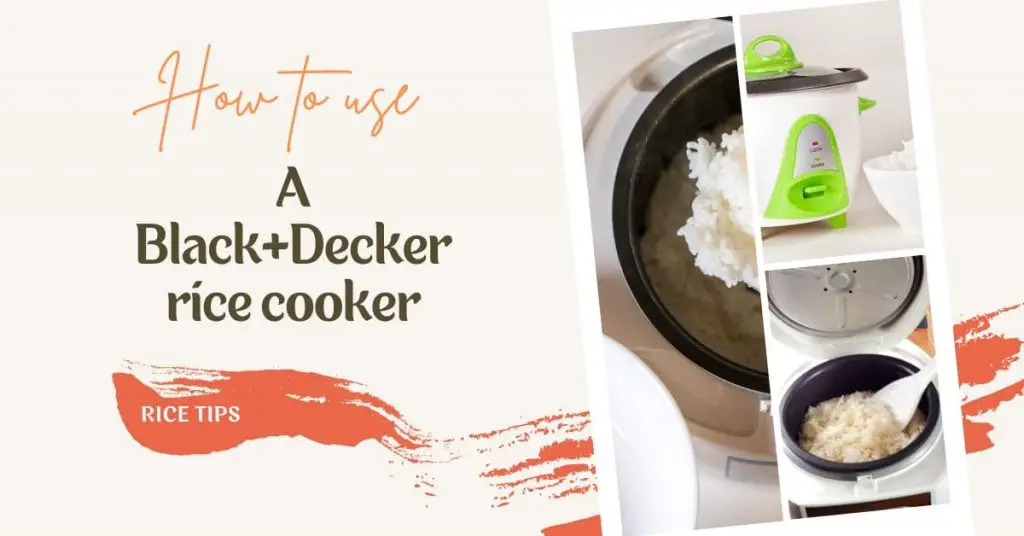When I bought my Black and Decker rice cooker, I thought it would be a game-changer, making perfectly cooked rice a breeze. But no matter what I did – adjusting the water-to-rice ratio, rinsing the rice thoroughly, or even trying different types of rice – I faced the same problem, my rice consistently stuck to the bottom of the pan, turning into a crusty, overcooked mess.
So, I decided to dig deeper and learn how to use this appliance correctly. I scoured through manuals, PDFs, and watched instructional videos, realizing that the issue lay with me and my approach to using the Black and Decker rice cooker.
Now, I’m here to share what I’ve discovered on how to make this rice cooker work like a charm. Follow these steps, and you’ll achieve fluffy, delicious rice without the hassle. Plus, you’ll unlock the versatility of this appliance, from quick cooking to steaming and even making soups and stews. It’s time for stress-free cooking with your Black+Decker rice cooker!
Without further ado let’s jump in!

How To Use A Black+Decker Rice Cooker: Step-By-Step?
1. Cooking Rice:
Step 1: Perfectly Measured Rice Begin by measuring your desired amount of rice using the provided measuring cup and add it to the cooking bowl. Keep in mind that the rice cup provided is not the same as a standard measuring cup; it holds ¾ cup (6 fluid oz.) of dry rice. However, this amount will yield 2 standard cups of cooked rice.
Step 2: Rinse and Drain Rinse the rice thoroughly with water to remove excess starch, then drain it.
Step 3: Water and Seasonings For white rice, fill the cooking bowl with water up to the line corresponding to the number of rice cups being cooked. You can also add butter, oil, or seasonings to taste.
Step 4: Setting Up Place the cooking pot into the cooking base and cover it with the lid.
Step 5: Power On Plug in the appliance; the warm indicator light will illuminate immediately. It will start heating on warm as soon as the cord is connected to the outlet.
Step 6: Start Cooking Push down the control switch to initiate the cooking process. The cook indicator light will turn on, and cooking will begin.
Step 7: The Finish Line Once your rice is ready, the control switch will automatically flip up and shift to the warm setting.
Step 8: Fluff and Rest For the best results, let the rice rest in the warm mode for 15 minutes with the lid securely in place. Before serving, always fluff the rice with the serving spoon.
Step 9: After Cooking Don’t forget to unplug the appliance when it’s not in use, and allow the rice cooker to cool down completely before cleaning.
2. Cooking Soups, Stews, and More:
Step 1: Mix Ingredients When preparing soups, stews, or other dishes, simply add your ingredients to the cooking bowl.
Step 2: Ready to Cook Place the cooking bowl into the cooking base and secure it with the lid.
Step 3: Power Up Plug in the appliance, and the warm indicator light will come on immediately. It starts heating on warm as soon as the cord is plugged in.
Step 4: Initiate Cooking Push down the control switch to start cooking. The cook indicator light will illuminate, indicating the cooking process.
Step 5: Timing It Right If needed, set a kitchen timer for cooking time. When your dish is ready, manually switch the appliance to warm by pushing up the control switch. Note that the rice cooker won’t switch to warm until all the liquids have boiled away. So, keep a close eye on the cooking progress and avoid leaving it unattended.
Step 6: After Use As always, unplug the appliance when it’s not in use, and allow it to cool down fully before cleaning.
Rice Cooking Tips:
Here are some additional tips to enhance your rice-cooking experience:
- To prevent boiling over, briefly remove the lid and stir for a couple of minutes. This allows excess liquid to evaporate and the mixture to cool slightly. Replace the lid and repeat if necessary.
- Consider using kosher salt, which dissolves faster than table salt. Adjust the quantity accordingly; about ¾ tsp. of kosher salt is recommended for each rice cup (6 fluid oz.) of uncooked rice.
- Store white rice in an airtight container in a cool, dark place for up to one year. Brown rice can last up to six months with proper storage, and refrigeration or freezing extends its shelf life.
- Experiment with broth, stock, or reconstituted bouillon for added flavor. In this case, you may not need additional salt.
- Avoid keeping small amounts of rice in the warm cycle for extended periods, as it can dry out the rice.
- If you dislike rice with a crust, easily peel it off and discard it.
- The taste and hardness of your rice will vary based on the quality and type of rice and the cooking time. Adjust the water amount for softer or firmer rice as desired.
- For grains not listed in the cooking chart, follow the package directions.
Now, armed with these insights, you’re ready to make the most of your Black+Decker Rice Cooker and elevate your culinary adventures!
What Are Additional Uses For Black+Decker Rice Cooker?
Packaged Foods:
When it comes to your Black+Decker rice cooker, its uses extend far beyond just perfecting rice. Let’s explore some creative culinary possibilities:
Condensed and Ready-to-Serve Soups, Pasta, and Stews:
- Bowl Limit: To ensure even cooking, avoid overfilling the cooking bowl above the largest water-marking cup level.
- Stirring Sensation: For consistent heating, remember to give your mixture a gentle stir now and then.
- Time It Right: Always set a kitchen timer when preparing soups and stews. The cooker’s control switch isn’t a reliable indicator of cooking time for these dishes.
- Meat Matters: When including meats or poultry, make sure they are boneless and cut into cubes no larger than 1½ inches. No need to brown them before cooking.
- Extra Liquid: If you’re incorporating rice or pasta into your soup, add extra liquid to the recipe.
- Frozen Veggies Tip: Frozen veggies cook quickly, so introduce them towards the end of the cooking time. Stir them into your soup or stew and allow the mixture to simmer for an additional 5 to 10 minutes.
- Quick Recipes: Opt for recipes that can be prepared in 60 minutes or less.
Oatmeal or Hot Cereals:
- Best Oats: Steel-cut oats work best for that hearty breakfast.
- Right Liquid Level: Avoid filling the bowl more than halfway with liquids since oatmeal expands during cooking.
- Stirring for Perfection: Just like with rice, occasional stirring promotes even heating.
- The Warm Note: Once your oatmeal is perfectly done, your rice cooker will automatically switch to the warm setting. Keep in mind, this setting is ideal for well-done oatmeal.
- Time-Sensitive: If you prefer a different consistency, keep a watchful eye on the cooking process and manually switch to warm when it suits your taste.
- Speedy Recipes: Choose recipes that can be cooked in an hour or less.
So, whether you’re whipping up a hearty stew or preparing a comforting bowl of oatmeal, your Black+Decker rice cooker is more versatile than you might have imagined. Get ready to explore a world of flavors and culinary delights!
How Much Rice And Water Do I Put In A Black+Decker Rice Cooker?
For white long-grain, jasmine, basmati, yellow, or medium-grain rice:
| Amount Of Rice | Amount Of Water | Approx. Cooking Time | Yield (Standard 8 Oz. Cups) |
| ½ rice measure | to 0.5 mark | 18 to 23 minutes | 1 cup |
| 1 rice measure | to 1 mark | 19 to 24 minutes | 2 cups |
| 1 ½ rice measure | to 1.5 mark | 20 to 25 minutes | 3 cups |
For brown rice:
| Amount Of Rice | Amount Of Water | Approx. Cooking Time | Yield (Standard 8 Oz. Cups) |
| ½ rice measure | 1 cup | 25 to 30 minutes | 1 cup |
| 1 rice measure | 1 ½ cups | 26 to 31 minutes | 2 cups |
How To Clean A Black+Decker Rice Cooker?
Maintaining your Black+Decker rice cooker is essential to ensure it continues to serve you delicious meals. Here’s a step-by-step guide to keeping it pristine:
Step 1: Safety First
Before diving into cleaning, always prioritize safety. Begin by unplugging the rice cooker and allowing it to cool completely. This ensures your protection while handling the appliance.
Step 2: Bowl and Lid TLC
Now, it’s time to tackle the cooking bowl and glass lid. Use warm, soapy water to wash them thoroughly. If you encounter stubborn food residue, here’s a trick: fill the bowl with warm, soapy water and let it soak for a bit before using a plastic scouring pad to clean it. The best part? Both the cooking bowl and glass lid are dishwasher safe, making cleanup a breeze.
Step 3: Rinse and Dry
After washing, ensure you rinse the components properly, removing any soap residue. Then, allow them to dry thoroughly before reassembling your rice cooker.
Step 4: Tending to the Base
Don’t forget to give the interior and exterior of the cooking base some attention. A soft, slightly damp cloth or sponge is all you need to gently wipe away any spills or splatters.
Important: Avoid Abrasives Never be tempted to use abrasive cleaners or scouring pads on the cooking base, as they can cause damage to the surfaces.
Step 6: Water Woes
In the unlikely event that water accidentally finds its way into the switch area or onto the heating plate, exercise patience. Let your rice cooker air out and dry completely before using it again.
By following these simple steps, you’ll ensure that your Black+Decker rice cooker stays in tip-top shape, ready to deliver countless delightful meals with ease.
How does a Black+Decker rice cooker work?
Ever wondered how your trusty rice cooker manages the cooking process so effortlessly? Well, it’s all about a clever bit of engineering involving magnets and heat. Let’s dive into the science:
The Magnetic Marvel:
At the heart of your rice cooker lies a magnetic switch responsible for controlling the circuit to the heater. This switch is held in place by a magnet.
Now, as you may know, magnets have a quirky trait – they lose their magnetic properties when exposed to high temperatures. In the case of rice cookers, this magnetic magic happens at slightly over 100°C.
Cook vs. Warm:
Your rice cooker’s cook/warm switch plays a pivotal role. It can send electric power to the heating element in one of two ways: low power for the warm setting and high power for the cook setting.
When you set your rice cooker to “cook,” the magnet works its charm by keeping the switch closed, allowing the heater to operate at full power.
The Water Dance:
As long as there’s water in the pot, something fascinating occurs. The heat generated by the heater is solely used to turn the water into steam, preventing the temperature from rising above 100°C. This means the magnet remains in action, keeping everything in check.
When Water Vanishes:
Now, here’s where things get intriguing. When the water is all gone, there’s nothing left to absorb the heat except the pot and the rice. Both can handle temperatures higher than 100°C. As a result, the pot’s temperature starts to climb, and so does the temperature of the magnet.
At a certain point, the magnet gets too hot, loses its magnetic properties – just as it’s designed to do – and releases its grip on the switch. This action shifts the cooker to the “warm” position.
Persistent Magnet:
Even if you try to switch it back to “cook” immediately, the pot quickly heats up, causing the magnet to lose its magnetism once more and reopen the switch.
Advances in Rice Cookers:
While this magnetic switch is the core of many traditional rice cookers, more advanced models offer additional functions, like slow cooking.
These advanced rice cookers incorporate sophisticated thermocouples and control circuits for the heater, expanding their culinary capabilities.
So, the next time you enjoy perfectly cooked rice from your trusty rice cooker, you’ll have a deeper appreciation for the magnetic marvel that makes it all possible.
Frequently asked questions:
How do you steam rice in a Black+Decker Rice Cooker?
Steaming rice is a piece of cake:
- For every cup of rice, pour in two cups of water.
- Add a pinch of salt (about a teaspoon).
- Optionally, drizzle in a tablespoon of oil.
- Feel free to spice things up with your favorite seasonings – it won’t affect the rice-making process.
- If your cooker has a timer, set it for around 40 minutes. Check it at the 10-minute mark, and sometimes, switch it off early for fluffier results. No timer? Use the prompts for various rice types on your cooker.
Can the Black+Decker rice cooker handle brown rice?
Absolutely! It’s versatile. Just remember, brown rice may need a bit more water. Check the rice package for the exact ratios. The magic here is that rice cookers rely on temperature, not time, so they adapt to the slower water absorption of brown rice.
Is it possible to overcook rice in a Black+Decker rice cooker?
There’s a bit of a myth-busting here. Most rice cookers don’t operate on fixed timers. They’re more like culinary wizards:
- The cooker senses the temperature, not time.
- As long as there’s water in the pot, the temperature won’t go beyond 212°F/100°C. When the water’s absorbed, the temperature rises, and the cooker senses it, stopping the cooking.
- When experimenting with brown rice, keep an eye on it. If the water level drops too low, check the rice. If it’s not done, add a bit more water and keep cooking. Take note of any adjustments for future reference.
How does the Black+Decker rice cooker work, anyway?
The secret lies in a magnetic switch and temperature control:
- A magnet holds the switch in place.
- This switch controls power to the heater, offering low power for “warm” and high power for “cook.”
- When water’s around, the pot stays at 100°C, and the magnet does its job.
- But when the water vanishes, both pot and rice can heat beyond 100°C, causing the magnet to release the switch into the “warm” position.
Can the Black+Decker Rice Cooker do more than rice?
You bet! Get creative:
- For packaged foods like soups, pasta, and stews, be cautious not to overfill the bowl and stir occasionally. Use a kitchen timer for best results.
- Venture into making oatmeal or hot cereals, but don’t fill the bowl too high with liquids. The warm setting works wonders for a creamy texture.
If you are looking to buy a new rice maker & cooker, i recommend you Black+Decker rice cooker.
Read Also:
- The ultimate guide to microwave oven cooking
- Aroma Rice Cooker How To Use: The Ultimate Guide for Perfectly Cooked Rice Every Time!
- How To Season A Carbon Steel Wok On Electric Stove: Step-By-Step Guide (2023)
- How To Use Nuwave Air Fryer (A Full Guide For Beginners)
- How To Use Dash Mini Waffle Maker – Easy Guide (Step-By-Step)






